Using a Mobile Device “App” and Proximal Remote Sensing Technologies to Assess Soil Cover Fractions on Agricultural Fields
Abstract
:1. Introduction
2. Materials and Methods
2.1. Study Area
2.2. Sampling Design and Field Data Collection Field
2.2.1. Photograph-Grid Method
2.2.2. App Method
2.2.3. Residue Cover Obtained from Digital Photograph-Grid Counting and the App Classification
2.2.4. Crop Residue Cover Estimation Using the Script Method
2.3. Statistical Analysis
3. Results
3.1. App-, Photograph-Grid and Script-Derived Residue Cover
3.2. Relationship between Residue Cover Obtained by App vs. Photograph and Script Methods
3.3. Exploring Non-Linear Relationship Alternative to Modelling the Residue Cover Data
4. Discussion
5. Conclusions
Acknowledgments
Author Contributions
Conflicts of Interest
Disclaimer
References
- Daughtry, C.S.T.; Hunt, E.R., Jr. Mitigating the effects of soil and residue water contents on remotely sensed estimates of crop residue cover. Remote Sens. Environ. 2008, 112, 1647–1657. [Google Scholar] [CrossRef]
- Kumar, K.; Goh, K.M. Crop residues and management practices: Effects on soil quality, soil nitrogen dynamics, crop yield and nitrogen recovery. Adv. Agron. 1999, 68, 197–319. [Google Scholar]
- Mailapalli, D.R.; Burger, M.; Horwath, W.R.; Wallender, W.W. Crop residue biomass effects on agricultural runoff. Appl. Environ. Soil Sci. 2013, 2013, 805206. [Google Scholar] [CrossRef]
- Enciso, J.; Nelson, S.D.; Perea, H.; Uddameri, V.; Kannan, N.; Gregory, A. Impact of residue management and subsurface drainage on non-point source pollution in the Arroyo Colorado. Sustain. Water Qual. Ecol. 2014, 3–4, 25–32. [Google Scholar] [CrossRef]
- Aguilar, J.; Evans, R.; Daughtry, C.S.T. Performance assessment of the cellulose absorption index method for estimating crop residue cover. J. Soil Water Conserv. 2012, 67, 202–210. [Google Scholar] [CrossRef]
- Molder, B.; Cockburn, J.; Berg, A.; Lindsay, J.; Woodrow, K. Sediment-assisted nutrient transfer from a small, no-till, tile drained watershed in Southwestern Ontario, Canada. Agric. Water Manag. 2015, 152, 31–40. [Google Scholar] [CrossRef]
- Shelton, D.P.; Dickey, E.C.; Jasa, P.J.; Kanable, R.; Smydra Krotz, S. Using the Line-Transect Method to Estimate Percent Residue Cover. Biol. Syst. Eng. 1990, G-20. Available online: https://digitalcommons.unl.edu/biosysengfacpub/289/ (accessed on 21 February 2018).
- Huggins, D.R.; Reganold, J.P. No-till: The quiet revolution. Sci. Am. 2008, 299, 70–77. [Google Scholar] [CrossRef] [PubMed]
- Lal, R. Sequestering carbon and increasing productivity by conservation agriculture. J. Soil Water Conserv. 2015, 70, 55A–62A. [Google Scholar] [CrossRef]
- OMAFRA. Great Lakes Agricultural Stewardship: Helping Ontario Farmers Keep the Great Lakes Healthy. 2015. Available online: https://news.ontario.ca/omafra/en/2015/02/great-lakes-agriculturalstewardship.html (accessed on 21 February 2018).
- Clarke, N.D.; Stone, J.A.; Vyn, T.J. Conservation tillage expert system for southwestern Ontario: Multiple experts and decision techniques. AI Appl. Nat. Resour. Manag. 1990, 4, 78–84. [Google Scholar]
- Patni, N.K.; Masse, L.; Jui, P.Y. Groundwater quality under conventional and no-tillage: I. Nitrate, electrical conductivity and pH. J. Environ. Qual. 1998, 27, 869–877. [Google Scholar] [CrossRef]
- Yang, W.; Sheng, C.; Voroney, P. Spatial targeting of conservation tillage to improve water quality and carbon retention benefits. Can. J. Agric. Econ. 2005, 53, 477–500. [Google Scholar] [CrossRef]
- Kochsiek, A.E.; Knops, J.M.H.; Brassil, C.E.; Arkebauer, T.J. Maize and soybean litter-carbon pool dynamics in three no-till systems. Soil Sci. Soc. Am. J. 2013, 77, 226–236. [Google Scholar] [CrossRef]
- Congreves, K.A.; Smith, J.M.; Németh, D.D.; Hooker, D.C.; Van Eerd, L.L. Soil organic carbon and land use: Processes and potential in Ontario’s long-term agro-ecosystem research sites. Can. J. Soil Sci. 2014, 94, 317–336. [Google Scholar] [CrossRef]
- Van Eerd, L.L.; Congreves, K.A.; Hayes, A.; Verhallen, A.; Hooker, D.C. Long-term tillage and crop rotation effects on soil quality, organic carbon and total nitrogen. Can. J. Soil Sci. 2014, 94, 303–315. [Google Scholar] [CrossRef]
- Smith, P.; Martino, D.; Cai, Z.; Gwary, D.; Janzen, H.; Kumar, P.; McCarl, B.; Ogle, S.; O’Mara, F.; Rice, C.; et al. Greenhouse gas mitigation in agriculture. Philos. Trans. R. Soc. 2008, 363, 789–813. [Google Scholar] [CrossRef] [PubMed]
- Ketcheson, J.W.; Stonehouse, D.P. Conservation tillage in Ontario. J. Soil Water Conserv. 1983, 38, 253–254. [Google Scholar]
- Dodd, V.A.; Grace, P.M.; Dickey, E.C.; Shelton, D.P.; Meyer, G.E.; Fairbanks, K.T. Determining crop residue cover with electronic image analysis. Biol. Syst. Eng. 1989, 3057–3063. Available online: https://digitalcommons.unl.edu/biosysengfacpub/238/ (accessed on 21 February 2018).
- Laamrani, A.; Joosse, P.; Feisthauer, N. Determining the number of measurements required to estimate crop residue cover by different methods. Soil Water Conserv. 2017, 72, 471–479. [Google Scholar] [CrossRef]
- Pacheco, A.; McNairn, H. Evaluating multispectral remote sensing and spectral unmixing analysis for crop residue mapping. Remote Sens. Environ. 2010, 114, 2219–2228. [Google Scholar] [CrossRef]
- Dehnen-Schmutz, K.; Foster, G.L.; Owen, L.; Persello, S. Exploring the role of smartphone technology for citizen science in agriculture. Agron. Sustain. Dev. 2016, 36, 1–9. [Google Scholar] [CrossRef]
- Statistics Canada. Table 004-0243—Census of Agriculture, Farms Reporting Technologies in the Year Prior to the Census. 2016. Available online: http://www5.statcan.gc.ca/cansim/a26?lang=eng&retrLang=eng&id=0040243&tabMode=dataTable&p1=-1&p2=11&srchLan=-1 (accessed on 22 February 2018).
- Booth, T.D.; Cox, S.E.; Berryman, R.D. Point sampling digital imagery with “SamplePoint”. Environ. Monit. Assess. 2006, 123, 97–108. [Google Scholar] [CrossRef] [PubMed]
- Lynch, T.M.H.; Barth, S.; Dix, P.J.; Grogan, D.; Grant, J.; Grant, O.M. Ground Cover Assessment of Perennial Ryegrass Using Digital Imaging. Agron. J. 2015, 107, 2347–2352. [Google Scholar] [CrossRef]
- Patrignani, A.; Ochsner, T.E. Canopeo: A Powerful New Tool for Measuring Fractional Green Canopy Cover. Agron. J. 2015, 107, 312–2320. [Google Scholar] [CrossRef]
- Karcher, D.E.; Richardson, M.D. Batch Analysis of Digital Images to Evaluate Turfgrass Characteristics. Crop Sci. 2005, 45, 1536–1539. [Google Scholar] [CrossRef]
- Confalonieri, R.; Foi, M.; Casa, R.; Aquaro, S.; Tona, E.; Peterle, M.; Boldini, A.; De Carli, G.; Ferrari, A.; Finotto, G.; et al. Development of an app for estimating leaf area index using a smartphone. Trueness and precision determination and comparison with other indirect methods. Field Crops Res. 2013, 96, 67–74. Available online: http://dx.doi.org/10.1016/j.compag.2013.04.019 (accessed on 21 February 2018). [CrossRef]
- Campos-Taberner, M.; Garcia-Haro, F.; Moreno, A.; Gilabert, M.; Sanchez-Ruiz, S.; Martinez, B.; Camps-Valls, G. Mapping leaf area index with a smartphone and Gaussian processes. IEEE Geosci. Remote Sens. Lett. 2015, 12, 2501–2505. [Google Scholar] [CrossRef]
- Vesali, F.; Omid, M.; Mobli, H.; Kaleita, A. Feasibility of using smart phones to estimate chlorophyll content in corn plants. Photosynthetica 2017, 55, 603–610. [Google Scholar] [CrossRef]
- Salk, C.F.; Sturn, T.; See, L.; Fritz, S.; Perger, C. Assessing quality of volunteer crowdsourcing contributions: Lessons from the Cropland Capture game. Int. J. Digit. Earth 2016, 9, 410–426. [Google Scholar] [CrossRef] [Green Version]
- Molinier, M.; López-Sánchez, C.A.; Toivanen, T.; Korpela, I.; Corral-Rivas, J.J.; Tergujeff, R.; Häme, T. Relasphone-Mobile and Participative In Situ Forest Biomass Measurements Supporting Satellite Image Mapping. Remote Sens. 2016, 8, 869. [Google Scholar] [CrossRef]
- FieldTRAKS Solutions. © FieldTRAKS Solutions 2004–2016. Available online: http://www.fieldtraks.ca/ (accessed on 15 January 2018).
- Kludze, H.; Deen, B.; Dutta, A. Report on Literature Review of Agronomic Practices for Energy Crop Production under Ontario Conditions. 2011, pp. 494–504. Available online: https://ofa.on.ca/uploads/userfiles/files/u%20of%20g%20ofa%20project-final%20report%20july%2004-2011%20 (accessed on 15 January 2018).
- Kludze, H.; Deen, B.; Weersink, A.; van Acker, R.; Janovicek, K.; De Laporte, A.; McDonald, A. Estimating sustainable crop residue removal rates and costs based on soil organic matter dynamics and rotational complexity. Biomass Bioenergy 2013, 56, 607–618. [Google Scholar] [CrossRef]
- Rasmussen, J.; Norremark, M.; Bibby, B.M. Assessment of leaf cover and crop soil cover in weed harrowing research using digital images. Weed Res. 2007, 47, 299–310. [Google Scholar] [CrossRef]
- Shelton, D.P.; Kanable, R.; Jasa, P.J. Estimating Percent Residue Cover Using the Line-Transect Method. Bol. Syst. Eng. 1993. Available online: digitalcommons.unl.edu/cgi/viewcontent.cgi?article=1255&context=biosysengfacpub (accessed on 21 February 2018).
- R Development Core Team. A Language and Environment for Statistical Computing. 2011. Available online: http://www.R-project.org/ (accessed on 15 January 2018).
- Hilbe, J.M. Modeling Count Data; Cambridge University Press: New York, NY, USA, 2014; Chapter 9. [Google Scholar]
- Singh, K.P.; Famoye, F. Analysis of Rates Using a Generalized Poisson Regression Model. Biom J. 1993, 35, 917–923. [Google Scholar] [CrossRef]
- Smithson, M.; Verkuilen, J. A Better Lemon Squeezer? Maximum-Likelihood Regression with Beta-Distributed Dependent Variables. Psychol. Methods 2006, 11, 54–71. [Google Scholar] [CrossRef] [PubMed]
- Cribari-neto, F.; Zeileis, A. Beta Regression in R. J. Stat. Softw. 2010, 34, 1–24. [Google Scholar] [CrossRef]
- Ryu, D.; Famiglietti, J.S. Characterization of footprint-scale surface soil moisture variability using Gaussian and beta distribution functions during the Southern Great Plains 1997 (SGP97) hydrology experiment. Water Resour. Res. 2005, 41, 1–13. [Google Scholar] [CrossRef]
- Ferrari, S.; Cribari-neto, F.; Ferrari, S.L.P.; Cribari-neto, F. Beta Regression for Modelling Rates and Proportions. J. Appl. Stat. 2004, 31, 799–815. [Google Scholar] [CrossRef]
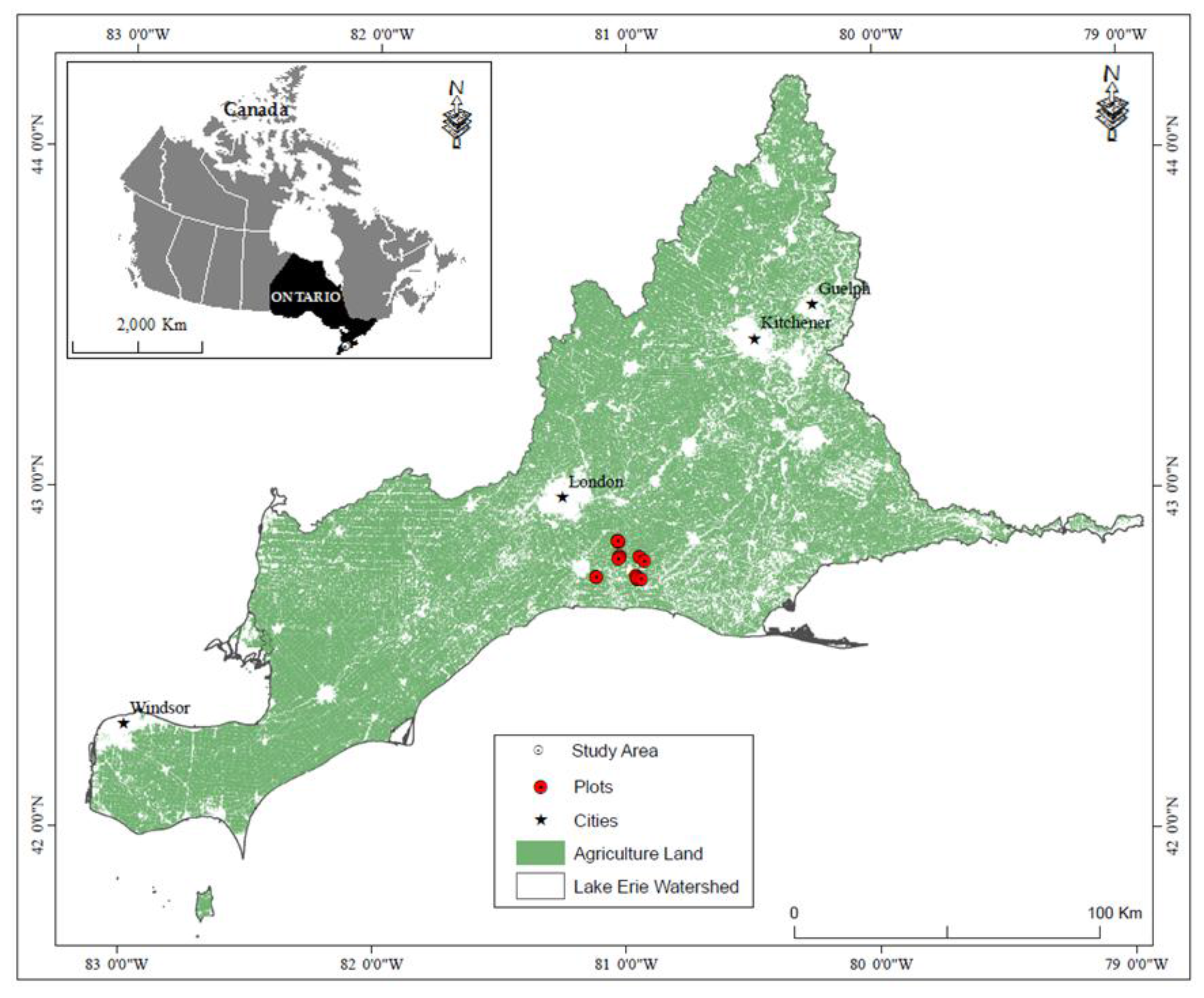
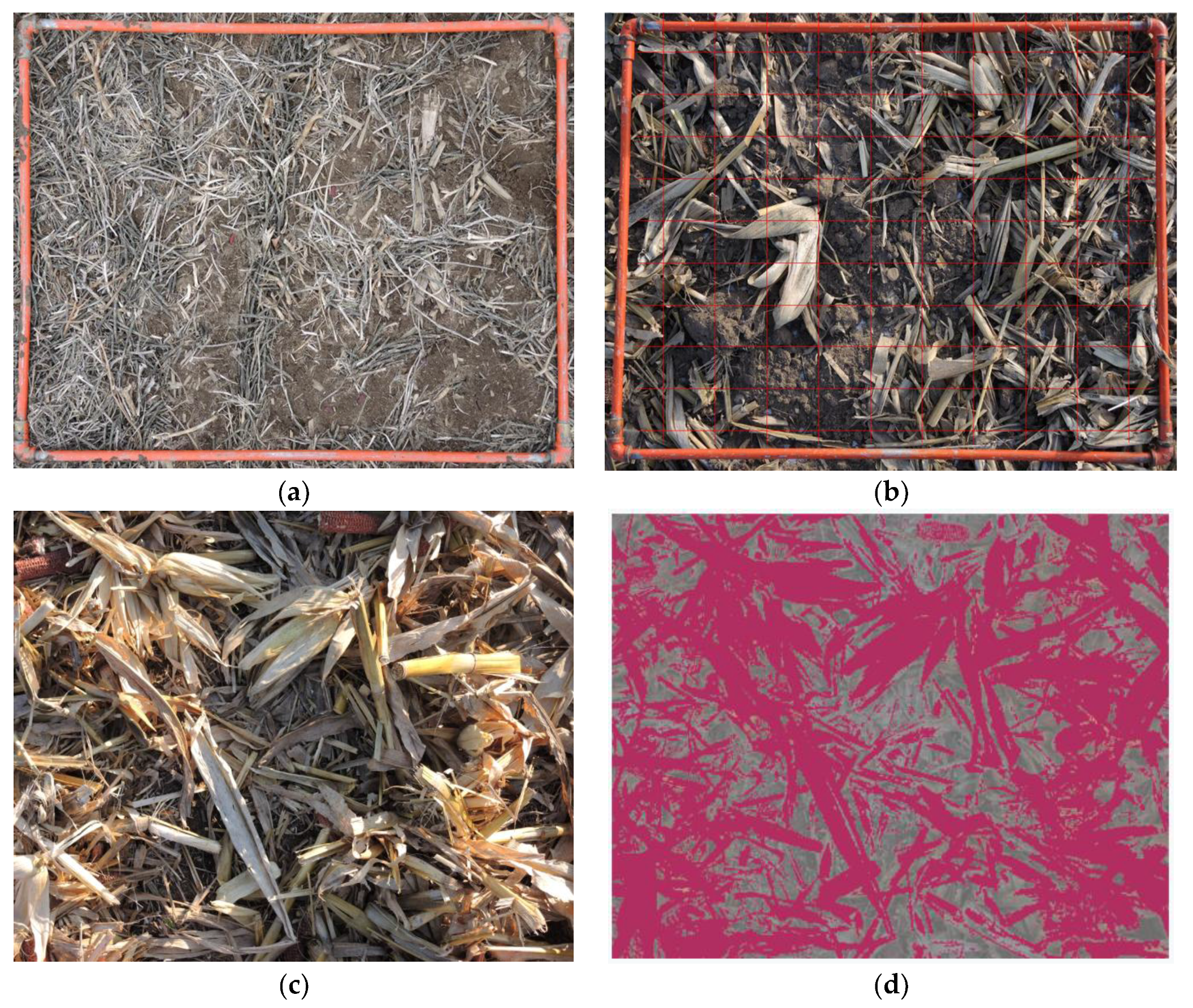

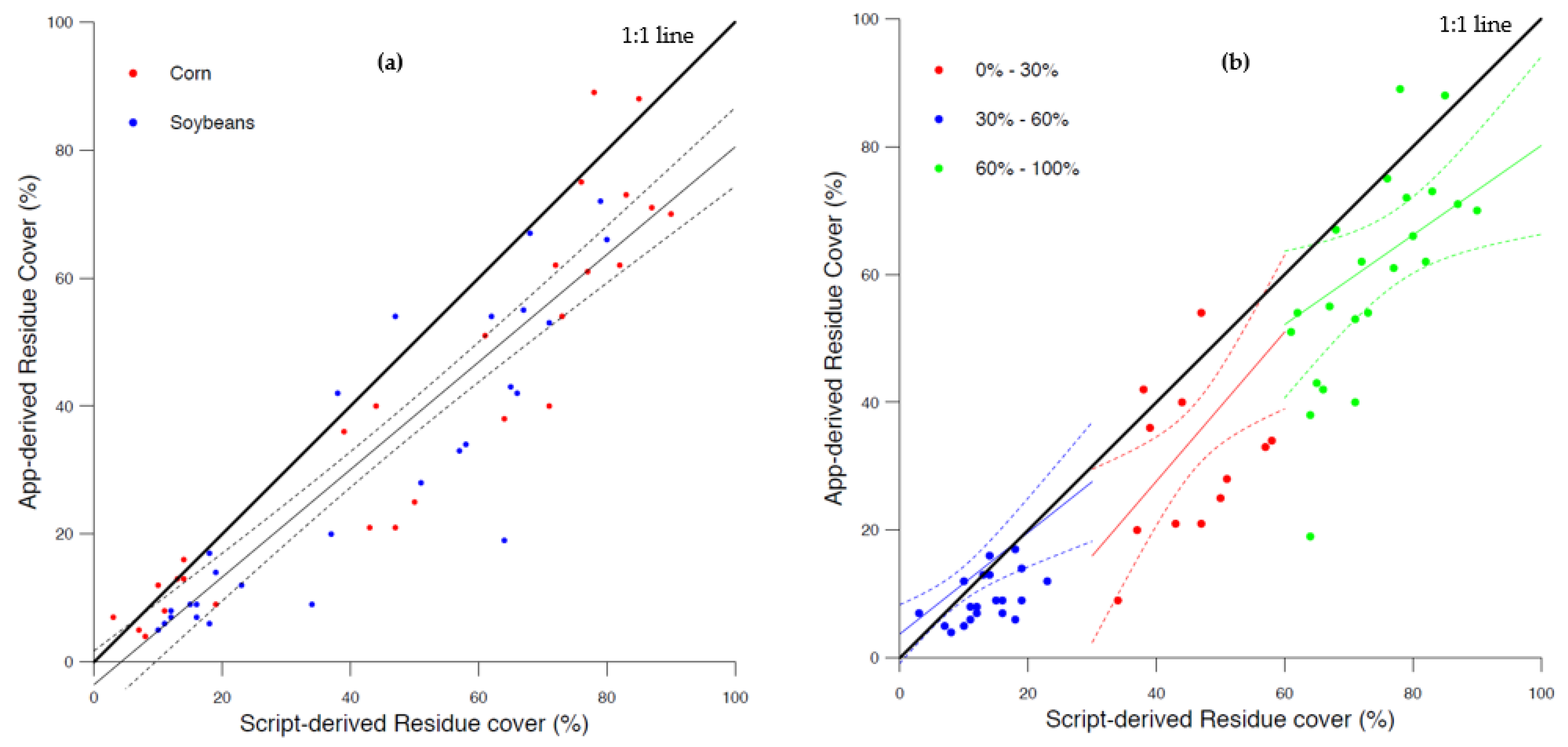
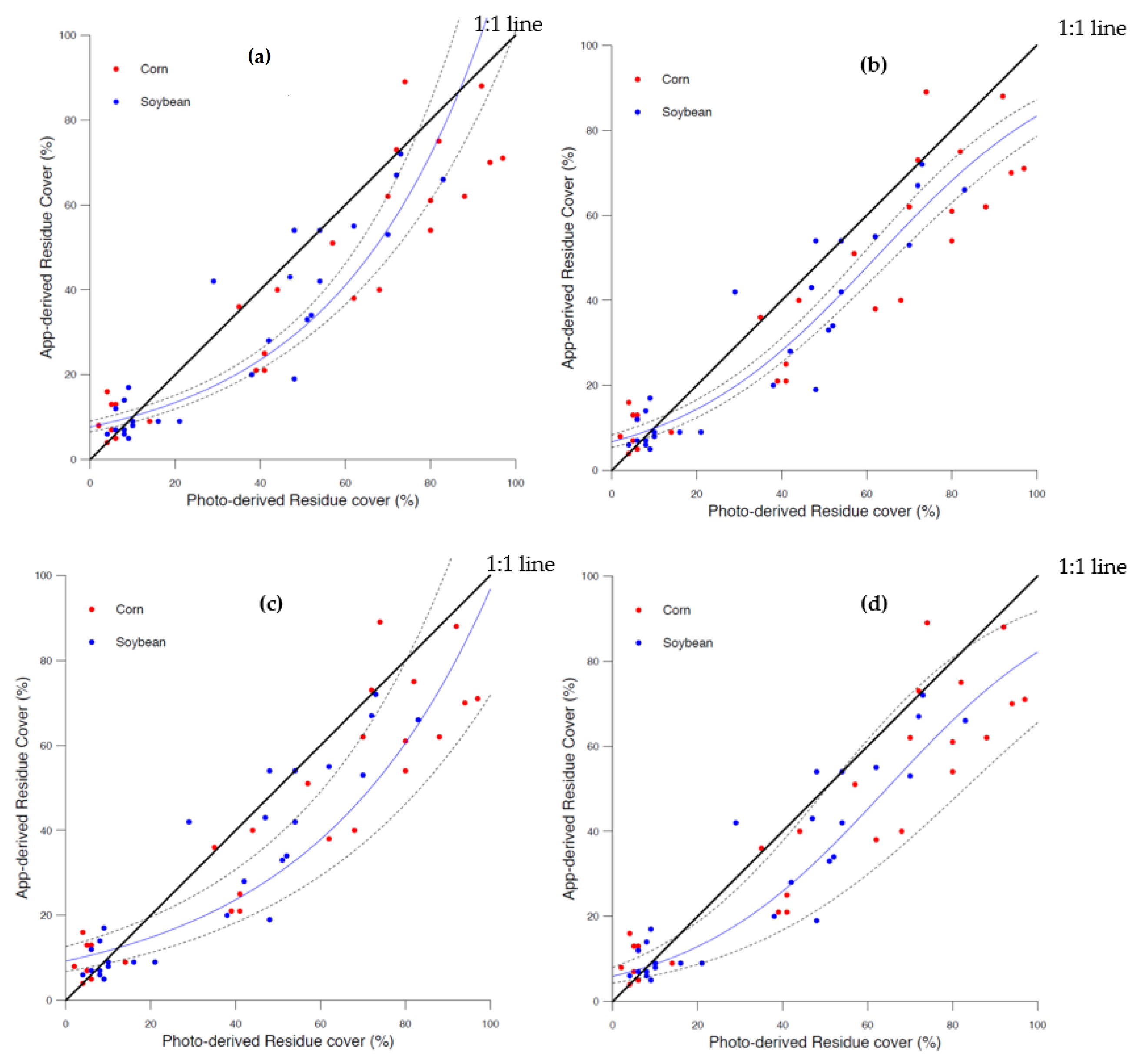
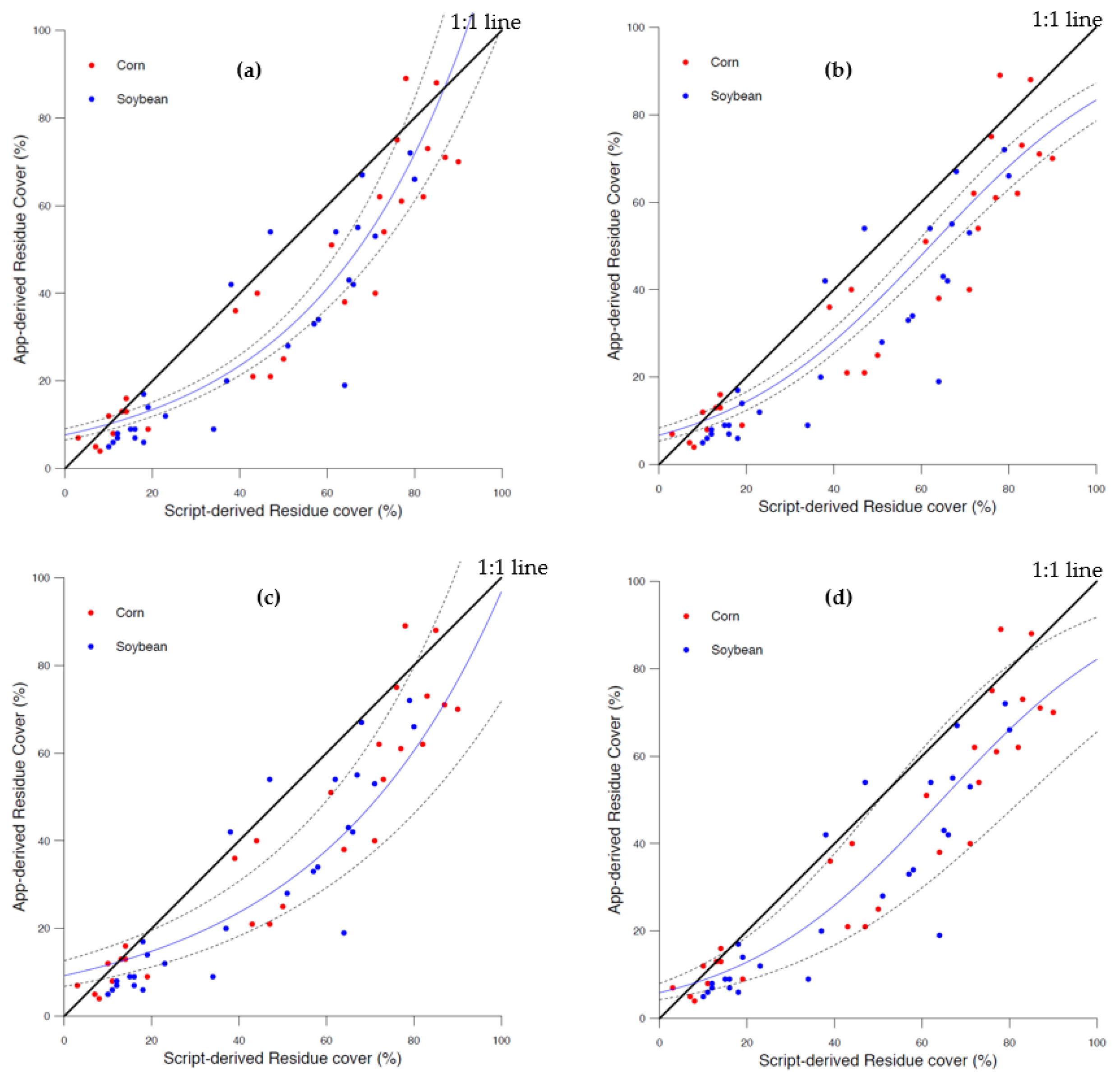
| Plot ID | Type | Photograph-Grid-Derived | Script-Derived | App-Derived | ||||||
|---|---|---|---|---|---|---|---|---|---|---|
| Mean | Range | SE | Mean | Range | SE | Mean | Range | SE | ||
| 1 | CR | 4 | 2–5 | 0.9 | 9 | 3–14 | 3.3 | 9 | 7–13 | 2.1 |
| 2 | CR | 5 | 4–6 | 0.7 | 12 | 10–14 | 1.3 | 14 | 12–16 | 1.3 |
| 3 | CR | 8 | 4–14 | 3.1 | 11 | 7–19 | 3.8 | 6 | 4–9 | 1.3 |
| 4 | CR | 47 | 35–62 | 8.1 | 49 | 39–64 | 7.6 | 38 | 36–40 | 1.1 |
| 5 | CR | 49 | 39–68 | 9.5 | 54 | 43–71 | 8.7 | 27 | 21–40 | 6.4 |
| 6 | CR | 59 | 41–80 | 11.3 | 61 | 50–73 | 6.6 | 43 | 25–54 | 9.3 |
| 7 | CR | 74 | 70–80 | 2.9 | 77 | 72–83 | 3.2 | 65 | 61–73 | 3.7 |
| 8 | CR | 87 | 82–92 | 2.9 | 81 | 76–85 | 2.6 | 75 | 62–88 | 7.7 |
| 9 | CR | 88 | 74–97 | 7.2 | 85 | 78–90 | 3.6 | 77 | 70–89 | 6.3 |
| 10 | SB | 7 | 6–8 | 0.5 | 15 | 12–18 | 1.8 | 7 | 6–7 | 0.5 |
| 11 | SB | 8 | 6–10 | 1.0 | 18 | 8–14 | 1.6 | 11 | 8–14 | 1.6 |
| 12 | SB | 11 | 4–21 | 5.1 | 21 | 11–34 | 6.8 | 11 | 6–17 | 3.5 |
| 11 | SB | 12 | 9–16 | 2.2 | 14 | 10–16 | 1.9 | 8 | 5–9 | 1.2 |
| 14 | SB | 38 | 29–48 | 5.6 | 41 | 37–47 | 3.2 | 39 | 20–54 | 10.2 |
| 15 | SB | 48 | 42–52 | 3.1 | 55 | 51–58 | 2.2 | 32 | 28–34 | 1.7 |
| 16 | SB | 58 | 48–73 | 7.7 | 68 | 62–79 | 5.4 | 48 | 19–72 | 15.6 |
| 17 | SB | 59 | 47–70 | 6.6 | 68 | 65–71 | 1.8 | 50 | 43–55 | 3.6 |
| 18 | SB | 70 | 54–83 | 8.5 | 71 | 66–80 | 4.4 | 58 | 42–67 | 8.1 |
| Residue | n | Photograph-Grid-Derived | Script-Derived | App-Derived | ||||||
|---|---|---|---|---|---|---|---|---|---|---|
| Mean | Range | SE | Mean | Range | SE | Mean | Range | SE | ||
| All | 54 | 41 | 2-97 | 4.1 | 45 | 3–90 | 3.8 | 34 | 4–89 | 3.5 |
| Corn | 27 | 47 | 2–97 | 6.5 | 49 | 3–90 | 5.9 | 39 | 4–89 | 5.3 |
| Soybean | 27 | 35 | 4–83 | 4.9 | 41 | 10–80 | 4.7 | 29 | 5–72 | 4.3 |
| Low | 22 | 9 | 2–29 | 1.3 | 16 | 3–38 | 1.7 | 11 | 4–42 | 1.7 |
| Medium | 15 | 46 | 35–57 | 1.7 | 53 | 37–66 | 2.5 | 35 | 19–54 | 3.2 |
| High | 17 | 77 | 62–97 | 2.6 | 77 | 64–90 | 1.8 | 64 | 38–89 | 3.4 |
| ≥30% | 32 | 63 | 35–97 | 3.2 | 65 | 37–90 | 2.6 | 50 | 19–89 | 3.5 |
| Residue | n | App vs. Photograph-Grid | App vs. Script | ||||||||||
|---|---|---|---|---|---|---|---|---|---|---|---|---|---|
| R2 | P | m | b | RMSE | Bias | R2 | P | m | b | RMSE | Bias | ||
| All | 54 | 0.86 | 0.00 * | 0.77 | 2.84 | 13.3 | −6.3 | 0.84 | 0.00 * | 0.84 | −3.45 | 15.4 | −10.8 |
| Corn | 27 | 0.86 | 0.00 * | 0.76 | 4.06 | 15.0 | −7.4 | 0.86 | 0.00 * | 0.84 | −1.77 | 14.7 | −9.6 |
| Soybean | 27 | 0.85 | 0.00 * | 0.80 | 1.59 | 11.2 | −5.3 | 0.79 | 0.00 * | 0.81 | −4.05 | 16.2 | −12.0 |
| Low | 22 | 0.40 | 0.00 † | 0.81 | 3.80 | 6.5 | 2.1 | 0.45 | 0.00 * | 0.66 | 0.63 | 7.9 | −4.6 |
| Medium | 15 | 0.40 | 0.00 ‡ | 1.18 | −19.47 | 14.6 | −11.2 | 0.13 | 0.17 | 0.47 | 9.81 | 21.8 | −18.0 |
| High | 17 | 0.27 | 0.03 ‡ | 0.70 | 10.40 | 17.7 | −13.0 | 0.43 | 0.00 † | 1.25 | −31.67 | 16.2 | −12.3 |
| ≥30% | 32 | 0.70 | 0.00 * | 0.91 | −6.73 | 16.4 | −12.1 | 0.65 | 0.00 * | 1.09 | −20.8 | 19.0 | −15.0 |
| Regression | App vs. Photograph-Grid | App vs. Script | ||||||
|---|---|---|---|---|---|---|---|---|
| R2 | P-Value | m (× 10−2) | b | R2 | P-Value | m (× 10–2) | b | |
| Log Transform | 0.84 | 0.00 * | 2.79 | 2.04 | 0.86 | 0.00 * | 3.11 | 1.78 |
| Logit Transform | 0.86 | 0.00 * | 4.24 | −2.63 | 0.86 | 0.00 * | 4.66 | −3.00 |
| Generalized Poisson | N/A | 0.00 * | 2.35 | 1.73 | N/A | 0.00 * | 2.79 | 1.50 |
| Beta | 0.86 ** | 0.00 * | 3.94 | −2.43 | 0.86 ** | 0.00 * | 4.29 | −2.77 |
© Her Majesty the Queen in Right of Canada as represented by the Minister of Agriculture and Agri-Food. Licensee MDPI, Basel, Switzerland. This article is an open access article distributed under the terms and conditions of the Creative Commons by Attribution (CC BY-NC-ND 4.0) license (https://creativecommons.org/licenses/by-nc-nd/4.0/).
Share and Cite
Laamrani, A.; Pardo Lara, R.; Berg, A.A.; Branson, D.; Joosse, P. Using a Mobile Device “App” and Proximal Remote Sensing Technologies to Assess Soil Cover Fractions on Agricultural Fields. Sensors 2018, 18, 708. https://doi.org/10.3390/s18030708
Laamrani A, Pardo Lara R, Berg AA, Branson D, Joosse P. Using a Mobile Device “App” and Proximal Remote Sensing Technologies to Assess Soil Cover Fractions on Agricultural Fields. Sensors. 2018; 18(3):708. https://doi.org/10.3390/s18030708
Chicago/Turabian StyleLaamrani, Ahmed, Renato Pardo Lara, Aaron A. Berg, Dave Branson, and Pamela Joosse. 2018. "Using a Mobile Device “App” and Proximal Remote Sensing Technologies to Assess Soil Cover Fractions on Agricultural Fields" Sensors 18, no. 3: 708. https://doi.org/10.3390/s18030708
APA StyleLaamrani, A., Pardo Lara, R., Berg, A. A., Branson, D., & Joosse, P. (2018). Using a Mobile Device “App” and Proximal Remote Sensing Technologies to Assess Soil Cover Fractions on Agricultural Fields. Sensors, 18(3), 708. https://doi.org/10.3390/s18030708






